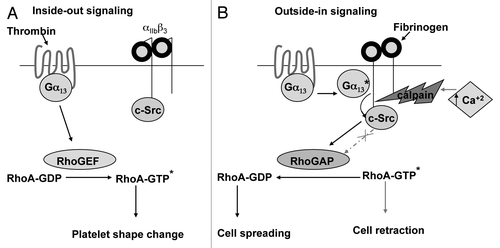Abstract
Under physiological conditions, circulating platelets are discoid in shape. On these platelets, the fibrinogen receptor (integrin αIIbβ3) is in a low-affinity state, unable to bind soluble fibrinogen (Fg). Activation by agonists such as ADP and thrombin leads to a change in the conformation of the integrin αIIbβ3 through a process known as inside-out signaling. This enables the integrin to bind soluble Fg, which initiates a cascade of events referred to as outside-in signaling. Outside-in signaling control processes such as platelet spreading and clot retraction by regulating small G-proteins such as RhoA, Rac and cdc42.
The majority of the physiological platelet agonists (except collagen) induce inside-out signaling by binding to specific G-protein-coupled receptors (GPCRs). A G-protein plays a crucial role in translating the signal from GPCR to downstream effector molecules, ultimately leading to affinity modulation of integrin αIIbβ3. Platelets express nine Gα subunits; namely Gq, Gi1, Gi2, Gi3, Gz, G12, G13, Gs and G16. Previous studies have shown that a small G-protein, RhoA, is activated by the G12/13 family and plays a crucial role in calcium-independent platelet shape change.Citation3 However, RhoA is also activated by αIIbβ3 and inhibits platelet spreading to trigger clot retraction.Citation4 Recently, in a series of elegant experiments, Gong et al. have described the dynamic regulation of RhoA through a signaling crosstalk between Gα13 and αIIbβ3.Citation5
By generating mice in which the platelets were depleted of Gα13 using siRNA technology, Gong et al. investigated the role of Gα13-mediated signaling on platelet spreading on immobilized Fg.Citation5 The confocal images very clearly showed that, in the absence of Gα13, platelets spread poorly on Fg, which was rescued by pretreatment with the Rho-kinase inhibitor Y27632, confirming previous findings that RhoA activated downstream of integrin αIIbβ3 inhibits platelet spreading. Interestingly, Gα13-depleted platelets failed to activate c-Src but accelerated RhoA activation. From these observations, the authors infer that Gα13 is important for integrin-mediated c-Src activation and RhoA inhibition, leading to increased cell spreading.Citation5
Since Gα13 regulates integrin-mediated cell spreading and c-Src activation, Gong et al. examined the interaction of Gα13 with αIIbβ3 using co-immunoprecipitation and GST pull-down assays.Citation5 They found that the GTP-bound form of Gα13 shows enhanced interaction with the integrin β3 subunit. This interaction is required for the activation of c-Src and the inhibition of RhoA. However, they found that the inhibition of RhoA is transient. RhoA activation is suppressed for the first 15 min of platelet spreading, after which RhoA is activated. This initial suppression is rescued by blocking Gα13 and β3 cytoplasmic domain (β3-CD) interaction. Furthermore, they observed that RhoA activation parallels clot retraction.Citation5 These findings indicate that Gα13 is a key regulator of platelet spreading and clot retraction phenomena.
According to Gong et al., thrombin-induced inside-out signaling through GPCR leads to GTP loading of Gα13 (). This GTP-bound Gα13 interacts with integrin β3-CD of ligand-bound integrin, thus facilitating c-Src activation, which leads to platelet spreading. Blockade of the interaction between Gα13 and β3-CD or cleavage of β3-CD by calpain results in clot retraction ().
Perhaps the most significant and novel finding of the study is the identification of integrin αIIbβ3 as an effector of Gα13. The study also convincingly shows that Gα13 bound to integrin regulates RhoA via c-Src. Furthermore, achieving 80% knockdown of Gα13 in an in vivo setting using siRNA represents a technological advancement. Since Gα13 binds to integrin β3-CD in a 1:1 stoichiometry, it appears that only a small population of integrin is regulated by Gα13, as there are far less Gα13 molecules in a single platelet than the number of αIIbβ3 molecules. This will require further investigation. Gong et al. also finds that an appreciable amount of Gα13 is associated with β3 in resting platelets, which requires some explanation.Citation5 It is also not clear if Gα13 remains bound to β3-CD or dissociates from the integrin during clot retraction.
Overall, this is a paradigm-shifting study that establishes the importance of the dynamic regulation of RhoA by Gα13 in order to achieve efficient platelet spreading and clot retraction.
Figures and Tables
Figure 1 Schematic representation of the dynamic regulation of RhoA by Gα13 during platelet activation. (A) Activation of platelets by thrombin receptors coupled to Gα13 leads to the activation of RhoA, leading to platelet shape change. (B) The change in the conformation of integrin to a high-affinity form results in fibrinogen binding to αIIbβ3. Active Gα13 binds to the cytoplasmic domain of β3 leading to the activation of c-Src, resulting in platelet spreading. The rise in intracellular calcium activates calpain, which cleaves the β3 cytoplasmic domain, releasing c-Src, which, resulting in the activation of RhoA, leads to cell retraction. *Denotes GTP-bound active form of G-proteins.

References
- Siess W, Weber PC, Lapetina EG. Activation of phospholipase C is dissociated from arachidonate metabolism during platelet shape change induced by thrombin or platelet-activating factor. Epinephrine does not induce phospholipase C activation or platelet shape change. J Biol Chem 1984; 259:8286 - 8292
- Shattil SJ, Kim C, Ginsberg MH. The final steps of integrin activation: the end game. Nat Rev Mol Cell Biol 2010; 11:288 - 300
- Offermanns S, Toombs CF, Hu YH, Simon MI. Defective platelet activation in G alpha(q)-deficient mice. Nature 1997; 389:183 - 186
- Flevaris P, Stojanovic A, Gong H, Chishti A, Welch E, Du X. A molecular switch that controls cell spreading and retraction. J Cell Biol 2007; 179:553 - 565
- Gong H, Shen B, Flevaris P, Chow C, Lam SC, Voyno-Yasenetskaya TA, et al. G protein subunit Galpha13 binds to integrin alphaIIbbeta3 and mediates integrin “outside-in” signaling. Science 2010; 327:340 - 343